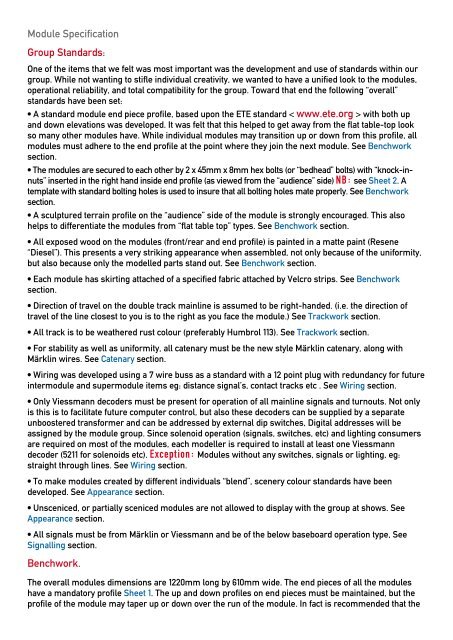The Auckland Märklin Club Inc - The Auckland Marklin Club Inc
The Auckland Märklin Club Inc - The Auckland Marklin Club Inc
The Auckland Märklin Club Inc - The Auckland Marklin Club Inc
Create successful ePaper yourself
Turn your PDF publications into a flip-book with our unique Google optimized e-Paper software.
Module Specification<br />
Group Standards:<br />
One of the items that we felt was most important was the development and use of standards within our<br />
group. While not wanting to stifle individual creativity, we wanted to have a unified look to the modules,<br />
operational reliability, and total compatibility for the group. Toward that end the following “overall”<br />
standards have been set:<br />
• A standard module end piece profile, based upon the ETE standard < www.ete.org > with both up<br />
and down elevations was developed. It was felt that this helped to get away from the flat table-top look<br />
so many other modules have. While individual modules may transition up or down from this profile, all<br />
modules must adhere to the end profile at the point where they join the next module. See Benchwork<br />
section.<br />
• <strong>The</strong> modules are secured to each other by 2 x 45mm x 8mm hex bolts (or “bedhead” bolts) with “knock-innuts”<br />
inserted in the right hand inside end profile (as viewed from the “audience” side) NB: see Sheet 2. A<br />
template with standard bolting holes is used to insure that all bolting holes mate properly. See Benchwork<br />
section.<br />
• A sculptured terrain profile on the “audience” side of the module is strongly encouraged. This also<br />
helps to differentiate the modules from “flat table top” types. See Benchwork section.<br />
• All exposed wood on the modules (front/rear and end profile) is painted in a matte paint (Resene<br />
“Diesel”). This presents a very striking appearance when assembled, not only because of the uniformity,<br />
but also because only the modelled parts stand out. See Benchwork section.<br />
• Each module has skirting attached of a specified fabric attached by Velcro strips. See Benchwork<br />
section.<br />
• Direction of travel on the double track mainline is assumed to be right-handed. (i.e. the direction of<br />
travel of the line closest to you is to the right as you face the module.) See Trackwork section.<br />
• All track is to be weathered rust colour (preferably Humbrol 113). See Trackwork section.<br />
• For stability as well as uniformity, all catenary must be the new style <strong>Märklin</strong> catenary, along with<br />
<strong>Märklin</strong> wires. See Catenary section.<br />
• Wiring was developed using a 7 wire buss as a standard with a 12 point plug with redundancy for future<br />
intermodule and supermodule items eg: distance signal’s, contact tracks etc . See Wiring section.<br />
• Only Viessmann decoders must be present for operation of all mainline signals and turnouts. Not only<br />
is this is to facilitate future computer control, but also these decoders can be supplied by a separate<br />
unboostered transformer and can be addressed by external dip switches, Digital addresses will be<br />
assigned by the module group. Since solenoid operation (signals, switches, etc) and lighting consumers<br />
are required on most of the modules, each modeller is required to install at least one Viessmann<br />
decoder (5211 for solenoids etc). Exception: Modules without any switches, signals or lighting, eg:<br />
straight through lines. See Wiring section.<br />
• To make modules created by different individuals “blend”, scenery colour standards have been<br />
developed. See Appearance section.<br />
• Unsceniced, or partially sceniced modules are not allowed to display with the group at shows. See<br />
Appearance section.<br />
• All signals must be from <strong>Märklin</strong> or Viessmann and be of the below baseboard operation type, See<br />
Signalling section.<br />
Benchwork.<br />
<strong>The</strong> overall modules dimensions are 1220mm long by 610mm wide. <strong>The</strong> end pieces of all the modules<br />
have a mandatory profile Sheet 1. <strong>The</strong> up and down profiles on end pieces must be maintained, but the<br />
profile of the module may taper up or down over the run of the module. In fact is recommended that the



